With the huge rising energy prices throughout Europe, I decided to finally do something that I had wanted to do for a fair while, and install a grid tied solar system to our house. With plenty of second hand panels for sale on multiple platforms, my maths said a budget of around £600 should be enough to build a 1.6kw system, and although there are a huge amount of variables like unpredictable prices and equally unpredictable British weather, I think a return of investment in 2-3years is very probable. This is a massive improvement from a lot of articles reporting that a 10-12 year ROI is a good return. So this was what, along with a few other things, gave me the spark to get on with it.
One of the other big factors was everything going on in Eastern Europe. Without getting into the political side of things too much, I don’t think Europe should be buying any energy from Russia right now (where possible). Also, the rising prices are only down to one major thing, and thats a simple case of supply and demand. So if we can lower the demand UK wide, all the better.
Anyway, the original idea was to fix 4 panels to my shed roof, but after plenty of research I decided to build a pergola like frame over the top, and fix 6 panels all on the same plane facing south-west at a lower than recommended 22degree pitch.
The frame was built using 4” timber posts in each corner. The 2 to the rear of the frame were concreted into the ground as they sat just inside the flower bed, and the 2 at the front were bolted to the ground using metposts. The upper frame was built using a mixture of 6”x2” and 4”x2”. This was because in places I couldn’t use a 6” timber as it was too tall, so I fixed a 4” timber to the roof instead.

Once this was done it was time to fit the panels. I managed to source some good panels off the Facebook marketplace. These were panels originally from a small solar farm near Southampton. The solar farm took quite a bit of damage from storm Eunice earlier in the year. The insurance company sold off all of the panels that were replaced, and I ended up with a bargain. I paid £50 per 275w panel, and bought 6 of them. Then it was a simple case of bolting them to the frame, and wiring them together. Wiring them together was a simple case of just plugging them into each other. Care must be taken doing this as they are wired in series, and the voltage increases with every panel.
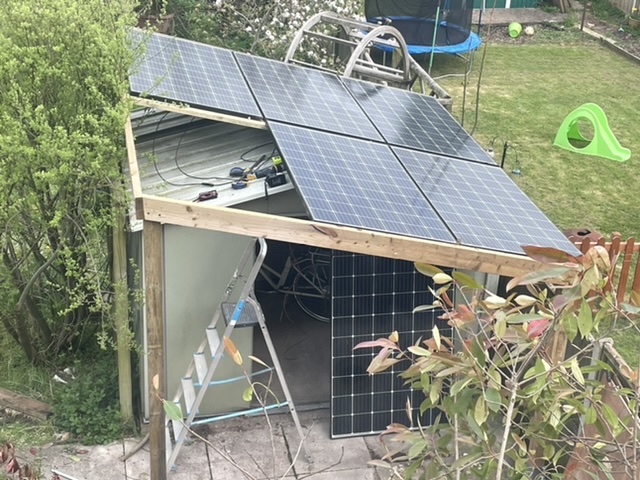
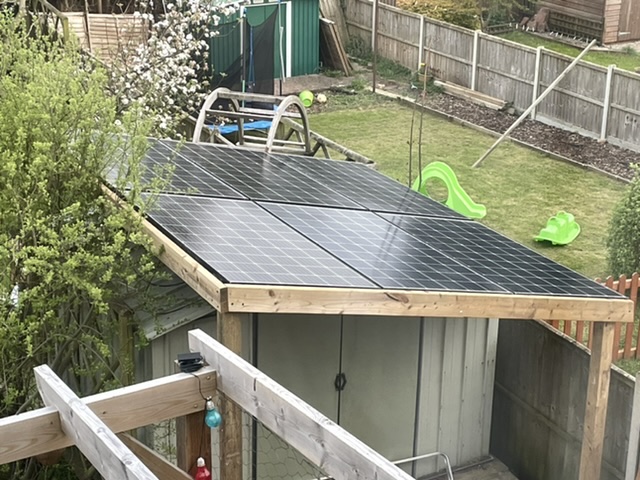
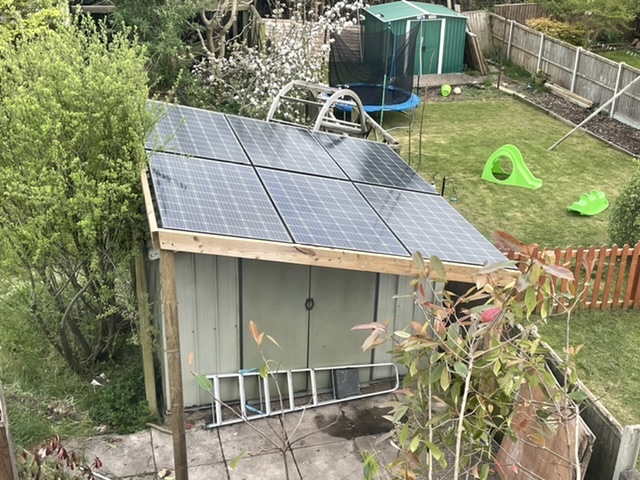
The cables came through the roof using a simple grommet from Amazon, then headed to the inverter. The inverter was a 1.5kw solis, and cost around £250. The wiring of this really was simple. All that was left was to put the cables into conduit, and it’s all signed off by the electrician.
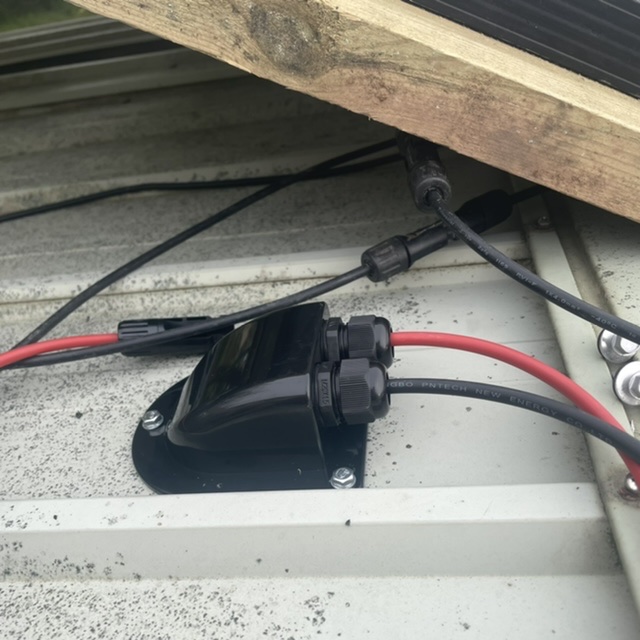
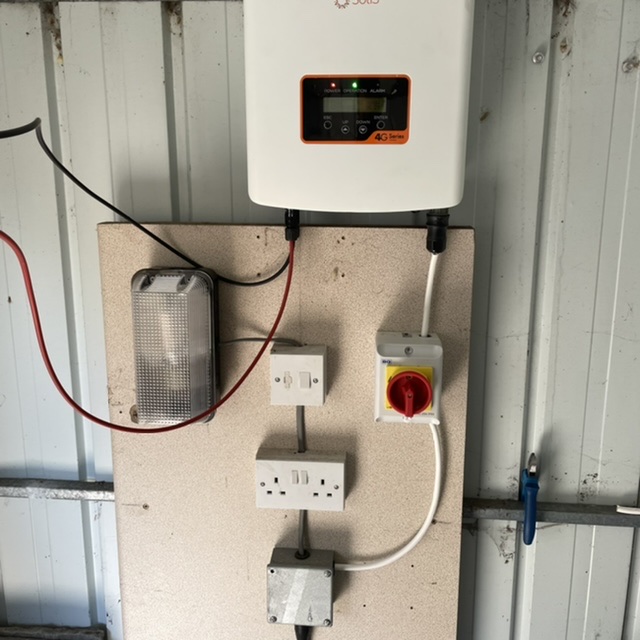
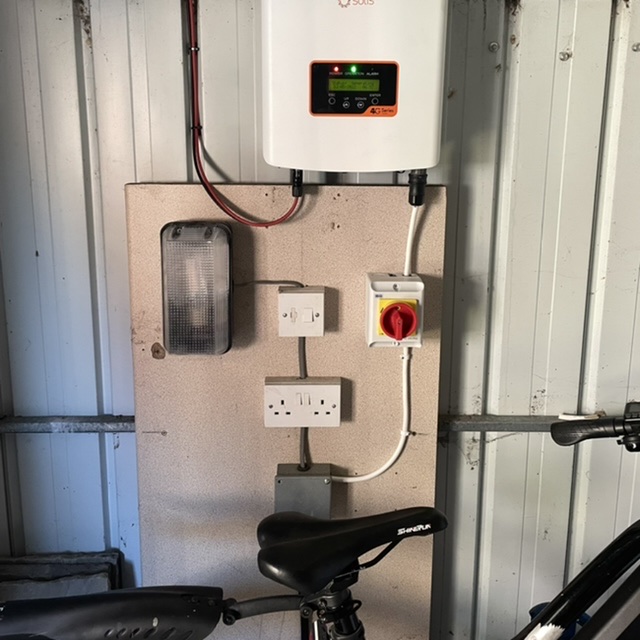
Since I switched the system on, on May 12th until sept 15th, the current recordings are as follows
126 days
Total generated 729kwh
Total exported 91kwh
Net gain 638kwh
27.8p per kwh, total savings £177.36
Highest daily generation 12.9kwh
Highest spike 1650w
This is generating a lot more than I expected so I think the 2 year ROI is a safe bet, although I have no idea what the winter will bring.
A Few interesting things I learnt along the way.
Panels lying flat are still 90% as efficient.
With a string inverter like I have, if you have 1 panel that’s underperforming from shade or any other issue, all of the other panels will drop to the same power as the least efficient. This is very apparent when the neighbours chimney casts a shadow onto the one corner of the one panel in this system. There are ways around this with either using micro-inverters, or installing optimisers on each panel.
If you have a power cut, the panels switch off automatically. This is to protect any engineers that could be working on the power lines further up the grid.
All in all, this has been a huge success so far, and I’m already planning on adding more panels to the setup.
Wow! This is a cool home project!
Hi @leighscotford,
Thank you for participating in the #teamuk curated tag. We have upvoted your quality content.
For more information visit our discord https://discord.gg/8CVx2Am
That is a nice rig. I know there are some shortages of new panels as people rush to get some installed. I had not considered second hand. Is this attached to your home circuits? I am considering getting some panels fairly soon, but may go for a professional install as I am no expert on this stuff, despite studying electrical engineering many years ago. There is some potential to mess it up. It is a shame that the house roof faces east and west really.
!PIZZA
Yes Steevc it’s connected to the house system. It’s a grid tied set up, so when we’re using more power than we are producing, we’re topped up with power from the grid. And when we’re producing more than we are using, it’s sent out for someone else to use. My roof really wasn’t ideal. It’s facing the wrong way, and the size/shape is awkward. So that’s why I mounted it on my shed roof instead.
PIZZA Holders sent $PIZZA tips in this post's comments:
@steevc(1/5) tipped @leighscotford (x1)
Join us in Discord!
Nice, thanks for posting that. I'm not in a position to be able to set one up myself but it's great to see how simple it can be.
Thanks for outlining how to do this. The most amazing figure was that the panels were still 90 per cent efficient when horizontal. Maybe I shouldn't be concerned about conflicting recommendations - the last article I read advised having a 35-degree pitch.
As utility prices rise, I turn to Conservice for stability. The company offers predictable electricity rates, helping me better manage my household budgets. To learn more about their services and receive individual advice, I call conservice customer service here. This will help you determine if their services meet your needs.
Hi - interesting read! Do you feed into the grid? Or is it an autarc circuit?
It feeds into the grid. But all excess produced goes into our emersion heater first, for our hot water.
Love it. Saving energy by heating up water is a good use case instead of feed too much into the grid.